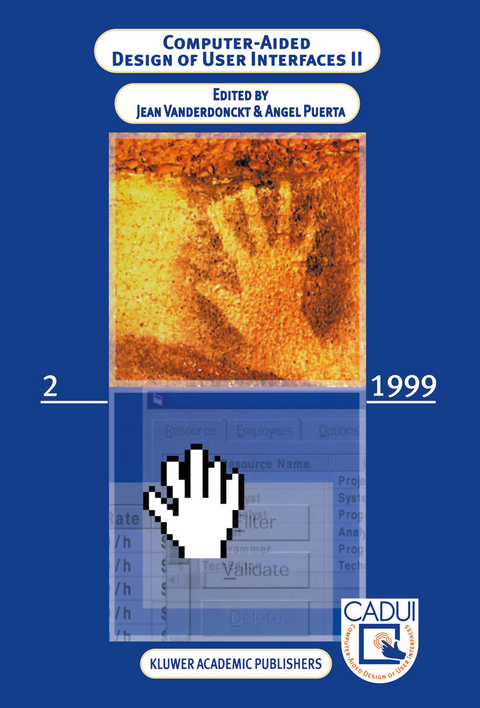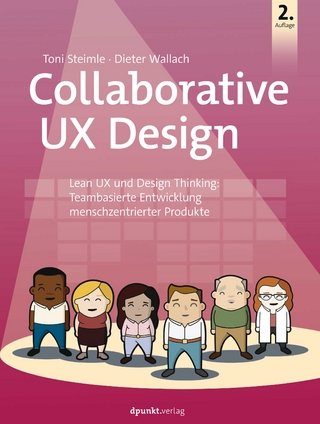
Computer-Aided Design of User Interfaces II
Springer (Verlag)
978-94-010-5861-2 (ISBN)
INTRODUCTION TO COMPUTER-AIDED DESIGN OF USER INTERFACES l 2 Jean Vanderdonckt and Angel Puerta ,3 Jlnstitut d'Administration et de Gestion - Universite catholique de Louvain Place des Doyens, 1 - B-1348 Louvain-la-Neuve (Belgium) vanderdonckt@gant,ucl. ac,be , vanderdoncktj@acm,org Web: http://www. arpuerta. com JKnowledge Systems Laboratory, Stanford University, MSOB x215 Stanford, CA 94305-5479, USA puena@camis. stanford. edu 3RedWhaie Corp. , 277 Town & Country Village Palo Alto, CA 94303, USA puerta@ redwhale. com Web: http://www. redwhale. com Computer-Aided Design of Vser Interfaces (CADUI) is hereby referred to as the particular area of Human-Computer Interaction (HCI) intended to provide software support for any activity involved in the development life cycle of an interactive application, Such activities namely include task analysis, contextual inquiry [l], requirements definition, user-centred design, application modelling, conceptual design, prototyping, programming, in- stallation, test, evaluation, maintenance, Although very recently addressed (e. g.
, [3]), the activity of re-designing an existing user interface (VI) for an interactive application and the activity of re-engineering a VI to rebuild its underlying models are also considered in CADVI. A fundamental aim of CADVI is not only to provide some software sup- port to the above activities, but also to incorporate strong and solid meth- odological aspects into the development, thus fostering abstraction reflection and leaving ad hoc development aside [5,7]. Incorporating such methodo- logical aspects inevitably covers three related, sometimes intertwined, facets: models, method and tools.
Invited speakers.- 1. Modeling for Component Based Development in UML/Catalysis.- 2. Theory Based Design: From Individual Users and Tasks to Collaborative Systems.- 3. Evaluating Accessibility and Usability of Web Pages.- Model-Based User Interface Development Environments.- 4. Model-Based Design of User Interfaces Using Object-Z.- 5. A Method Engineering Framework for Modeling and Generating Interactive Applications.- 6. GIPSE, A Model-Based System for CAD Software.- 7. Visto: A More Declarative GUI Framework.- 8. Beyond Automatic Generation-Exploratory Approach to UI Design.- 9. Using Application Domain Specific Run-Time Systems and Lightweight User Interface Models - A Novel Approach for CADUI.- 10.XXL: A Visual+Textual Environment for Building Graphical User Interfaces.- Linking and Deriving Models.- 11. Semi-Automated Linking of User Interface Design Artifacts.- 12. The Teallach Tool: Using Models for Flexible User Interface Design.- 13. MDL: A Language for Binding User-Interface Models.- Windows management.- 14. Vanishing Windows: An Empirical Study of Adaptive Window Management.- 15. Adaptive Layout Calculation in Graphical User Interfaces: A Retrospective on the A2DL-Project.- 16. Semantic Differences Between User Interface Platforms Relevance to Design and Re-Design of User Interface.- Design Frameworks and Objects.- 17. A Framework for Management of Sophisticated User Interface’s Variants in Design Process: A Case Study.- 18. Grasyla: Modelling Case Tool GUIs in MetaCases.- 19. User Defined Objects are First Class Citizen.- Supporting Task-Based Design.- 20. The Visual Task Model Builder.- 21. Computer-Aided Analysis of Cooperative Applications.- 22. Methodological and Tool Support for a Task-Oriented Development of Interactive Systems.- 23. Modelling Work:Workflow and Task Modelling.- Computer-Aided Design of User Interfaces.- 24. A Generic Framework based on Ergonomics Rules for Computer Aided Design of User Interface.- 25. CMF: A Coherent Modelling Framework for Task-Based User Interface Design.- 26. Towel: Real World Mobility on the Web.- 27. Tool-Based Support for User-Designer Collaboration in Distributed User Interface Design and Evaluation.- Computer-Aided Evaluation of User Interfaces.- 28. An Approach of Computer-Aided Choice of UI Evaluation Criteria and Methods.- 29. Considerating Subjectivity in Software Evaluation - Application for Teachware Evaluations.- 30. KALDI: A Computer-Aided Usability Engineering Tool for Supporting Testing and Analysis of Human-Computer Interaction.
| Zusatzinfo | VII, 356 p. |
|---|---|
| Verlagsort | Dordrecht |
| Sprache | englisch |
| Maße | 160 x 240 mm |
| Themenwelt | Mathematik / Informatik ► Informatik ► Betriebssysteme / Server |
| Mathematik / Informatik ► Informatik ► Grafik / Design | |
| Informatik ► Software Entwicklung ► User Interfaces (HCI) | |
| Informatik ► Theorie / Studium ► Künstliche Intelligenz / Robotik | |
| Informatik ► Weitere Themen ► CAD-Programme | |
| ISBN-10 | 94-010-5861-X / 940105861X |
| ISBN-13 | 978-94-010-5861-2 / 9789401058612 |
| Zustand | Neuware |
| Haben Sie eine Frage zum Produkt? |
aus dem Bereich


